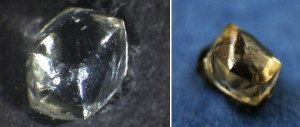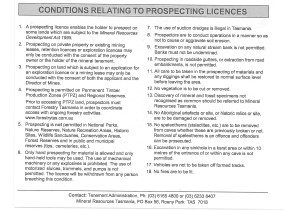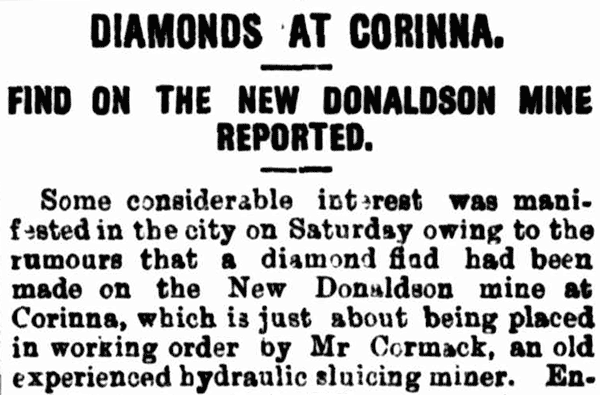When thinking Tasmanian diamonds, most people have heard of Killiecrankie diamonds, which are really topaz (and very good topaz at that). However, several real, verified diamonds have also been found in Tasmania.
Where have Tasmanian diamonds been found?
All verified Tasmanian diamonds have come from the northwest part of the state. Most of these were found in the goldfields around Corinna, as well as Harvey Creek, closer to Savage River mine. One diamond was also reputedly found in a parcel of ‘gem sands’ from the Hellyer River sent to England for evaluation by the Van Diemen’s Land Company. Petterd, in his Catalogue of the Minerals of Tasmania (1910) stated that this find was unverified, though it continues to get reported today.
The first reported diamond find was brought into Launceston by a prospector named Harvey. It was reported to have come from the New Donaldson Mining Company’s ground at the headwaters of Sunday Creek (north of Mt Donaldson). Harvey also later brought in another from Harveys Creek. Twelvetrees (1918) mistakenly stated that the diamond came from Sunday Creek, a creek that drains Mount Donaldson into the Savage River. In reality Sunday creek drains into the Donaldson River, and the New Donaldson Company’s ground extended over the headwaters of both Sunday Creek and Guthrie Creek, so it’s difficult to be perfectly sure of the exact location. Harveys Creek is described by Twelvetrees as a tributary of Badger Creek (nowadays Savage Creek), however newspaper reports from that time clearly describe it as “one of the principal tributaries of the Little Savage River, just above its confluence with the Savage River proper”. This is a common occurrence, as the place names have changed, or they might not have been formally named at that stage in the first place, and the area was very remote and poorly surveyed at the time. For a bit more discussion of the problem with place names, and Tasmanian diamonds in general, see Ralph Bottrill’s Diamonds in Tasmania (1998).

Locations where Tasmanian diamonds have been found. Base map courtesy of LISTmap.
Five more diamonds were eventually brought in by another prospector named Lawson, which came from somewhere in the Donaldson Range. Twelvetrees believed they were from either Middleton Creek or Badger Creek. However newspaper reports from earlier place Lawson’s find at Sunday Creek as well. Other finds by a Mr Gill (Long Plains or Harveys Creek or Whyte River area) and a Mr. Batty (Harveys Creek) are also reported.
Eventually some 16 or 18 Tasmanian diamonds were found that have been verified as such. Most of these came from the New Donaldson mining company’s grounds in the headwaters if Guthrie and Sunday creeks, and from Harveys Creek. Reports and rumours of many others exist. The diamonds are small enough (1/8 – 1/3 of a carat) that they would have been easily missed, or mistaken for quartz or topaz crystals, which are common in most of the area.

Two Tasmanian diamonds. Tasmanian Museum and Art Gallery collection. Photo: Ralph Bottrill via Mindat.org.
Most of the early written references on Tasmanian diamonds have speculated that they’re most likely freed from the ultramafic bodies in the Bald Hill area. Occurrences of Tasmanian diamond were very strongly correlated with occurrences of osmiridium (as known at the time). Rumours of diamonds at Adamsfield, the other main location with ultramafic geology and osmiridium, have made the rounds. So far as I know none have been confirmed (and colourless topaz is not entirely uncommon there).
Modern exploration
Exploration for diamonds has been carried out in more modern times. The search has focused on both diamonds as a standalone commodity and as an accessory to other economic minerals such as gold.
The Mount Lyell Mining and Railway Company held exploration licence EL26/1978 covering the Corinna and Bald Hill areas. They did not find significan indicator minerals before relinquishing the licence. Base Resources believed that the Moina area was also potentially prospective for diamonds, and held EL29/1983 for a few years. They also did not find any indicator minerals or diamonds.
In more modern times, Rio Tinto believed that Tasmanian diamonds could have come from diamondiferous “pipe-like structures” that are vissible as bullseye-like magnetic anomalies. They took out EL36/1996, but as in previous instances, found nothing encouraging. Their 1997 report is probably the most comprehensive of the lot, and includes a review and some copies of all relevant previous exploration in the area.
Is it worth going to find some?
Harvey Creek is pretty inaccessible, but currently free ground. There are no current mining leases or exploration licences covering the area. This means that a prospecting licence is all you need to get started. A helicopter might also help!
Middleton Creek is under exploration licence EL36/2010, but is easy access, as the Western Explorer road runs right through it. If you have a prospecting licence and you manage to secure permission, it’s fair game.

Scan of a 2015 Tasmanian prospecting licence. Condition 5 bans prospecting within Nature Recreation Areas.
The area around Mount Donaldson is easy to access from the Western Explorer road, and currently under Exploration Release Area (ERA) as of August 2015. This means that Mineral Resources Tasmania (MRT) is actively encouraging people to take this up for exploration. If you have a prospecting licence, you’re allowed to prospect inside ERAs without any further hassle. Interestingly, much of this ERA overlaps the Donaldson River Nature Recreation Area. If you have a prospecting licence, you’re not allowed to prospect inside Nature Recreation Areas (see condition 5 on a scan of my licence on the right). This means that you’d have to take up the ground sight-unseen, and in my opinion, this severely discriminates against small-time prospectors compared to mining companies. Given that MRT are trying to flog the area as highly prospective, to the extent of setting up an ERA, the ban on prospecting seems ridiculous. I have written to the Registrar of Mines in early May 2015 to raise this issue, and three months later I still haven’t received a response. I would encourage anyone interested to write to either the Registrar or Director of Mines and raise the issue as well. Their address is:
Director (or Registrar) of Mines, PO Box 56, Rosny Park 7018, Tasmania.
Your chances of finding real Tasmanian diamonds are probably slim, but you might also find a little gold, and half the fun is in the search!
Do you like the content at Apple Isle Prospector? Feel free to get in contact, or leave a comment.


I am getting a bit long in the tooth now but all I can think of is finding a bit of gold and or a diamond or two , I love the search , the bush the old tales and history,i have spent a bit of my time scatching about at corrina and other places, I have spent a lot of time in the bush I had a kingbilly lease 4 about 24 years that was a bit rugged cheers bob
Thanks Bob, I definitely know what you mean! I love Corinna, and the bush on the west coast. You feel like you’re not a part of this world. Did you ever come across something that might have been a diamond? The problem is there is also topaz coming in the alluvials from the Meredith Range granite… It would be great to see Tasmanian diamonds ‘rediscovered’.